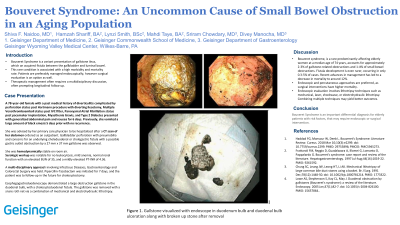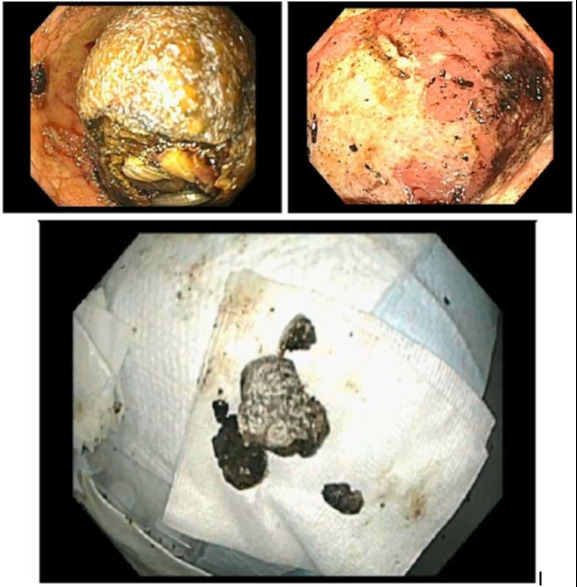Sunday Poster Session
Category: Biliary/Pancreas
P0103 - Bouveret Syndrome: An Uncommon Cause of Small Bowel Obstruction in the Aging Population
Sunday, October 22, 2023
3:30 PM - 7:00 PM PT
Location: Exhibit Hall

Has Audio

Shiva F. Naidoo, MD
Geisinger Health System
Wilkes-Barre, PA
Presenting Author(s)
Shiva F. Naidoo, MD1, Hamzah Shariff, BA2, Lynzi Smith, BSc2, Mahdi Taye, BA2, Sriram F. Chowdary, MD3, Divey Manocha, MD3
1Geisinger Health System, Wilkes-Barre, PA; 2Geisinger Commonwealth School of Medicine, Scranton, PA; 3Geisinger Health System, Scranton, PA
Introduction: Bouveret Syndrome is a variant presentation of gallstone ileus, which an acquired fistula between the gallbladder and luminal bowel. This rare condition is associated with a high morbidity and mortality rate. Patients are preferably managed endoscopically, however surgical evaluation is an option as well. Therapeutic management often requires a multidisciplinary discussion, often prompting longitudinal follow up.
Case Description/Methods:
A 78-year-old female with a past medical history of diverticulitis complicated by perforation status post Hartmann procedure with diverting ileostomy, Multiple Venothromboemboli status post IVC filter, Paroxysmal Atrial Fibrillation status post pacemaker implantation, Myasthenia Gravis, and Type 2 Diabetes presented with generalized abdominal pain and nausea for 6 days. Previously, she vomited a large amount of black emesis 5 days prior with no recurrence.
She was advised by her primary care physician to be hospitalized after a CT scan of her abdomen ordered as an outpatient. Gallbladder perforation with pneumobilia and concerns for an underlying choleduodenal or cholegastric fistula with a possible gastric outlet obstruction by a 27 mm x 37 mm gallstone was observed. She was hemodynamically stable on room air. Serologic workup was notable for no leukocytosis, mild anemia, normal renal function with an elevated BUN of 35, and a mildly elevated PT-INR of 4.36. A multi-disciplinary approach involving Infectious Diseases, Gastroenterology and Colorectal Surgery was held. Pipercillin-Tazobactam was initiated for 7 days, and the patient was to follow-up in the future for cholecystectomy. Esophagogastroduodenoscopy demonstrated a large obstruction gallstone in the duodenal bulb, with a cholecystoduodenal fistula. The gallstone was removed with a snare roth net via a combination of mechnaical and electrohydraulic lithotripsy.
Discussion: Bouveret syndrome, is a rare predominantly affecting elderly women at a median age of 74 years, accounts for approximately 2-3% of gallstone-related obstructions and 1-4% of small bowel obstructions. Fistula development is even rarer, occurring in only 0.3-5% of cases. Recent advances in management has led to a decrease in mortality to around 12%. Endoscopic and percutaneous approaches are preferred, as surgical interventions have higher mortality. Endoscopic evaluation involves lithotripsy techniques such as mechanical, laser, shockwave, or electrohydraulic lithotripsy. Combining multiple techniques may yield better outcomes.

Disclosures:
Shiva F. Naidoo, MD1, Hamzah Shariff, BA2, Lynzi Smith, BSc2, Mahdi Taye, BA2, Sriram F. Chowdary, MD3, Divey Manocha, MD3. P0103 - Bouveret Syndrome: An Uncommon Cause of Small Bowel Obstruction in the Aging Population, ACG 2023 Annual Scientific Meeting Abstracts. Vancouver, BC, Canada: American College of Gastroenterology.
1Geisinger Health System, Wilkes-Barre, PA; 2Geisinger Commonwealth School of Medicine, Scranton, PA; 3Geisinger Health System, Scranton, PA
Introduction: Bouveret Syndrome is a variant presentation of gallstone ileus, which an acquired fistula between the gallbladder and luminal bowel. This rare condition is associated with a high morbidity and mortality rate. Patients are preferably managed endoscopically, however surgical evaluation is an option as well. Therapeutic management often requires a multidisciplinary discussion, often prompting longitudinal follow up.
Case Description/Methods:
A 78-year-old female with a past medical history of diverticulitis complicated by perforation status post Hartmann procedure with diverting ileostomy, Multiple Venothromboemboli status post IVC filter, Paroxysmal Atrial Fibrillation status post pacemaker implantation, Myasthenia Gravis, and Type 2 Diabetes presented with generalized abdominal pain and nausea for 6 days. Previously, she vomited a large amount of black emesis 5 days prior with no recurrence.
She was advised by her primary care physician to be hospitalized after a CT scan of her abdomen ordered as an outpatient. Gallbladder perforation with pneumobilia and concerns for an underlying choleduodenal or cholegastric fistula with a possible gastric outlet obstruction by a 27 mm x 37 mm gallstone was observed. She was hemodynamically stable on room air. Serologic workup was notable for no leukocytosis, mild anemia, normal renal function with an elevated BUN of 35, and a mildly elevated PT-INR of 4.36. A multi-disciplinary approach involving Infectious Diseases, Gastroenterology and Colorectal Surgery was held. Pipercillin-Tazobactam was initiated for 7 days, and the patient was to follow-up in the future for cholecystectomy. Esophagogastroduodenoscopy demonstrated a large obstruction gallstone in the duodenal bulb, with a cholecystoduodenal fistula. The gallstone was removed with a snare roth net via a combination of mechnaical and electrohydraulic lithotripsy.
Discussion: Bouveret syndrome, is a rare predominantly affecting elderly women at a median age of 74 years, accounts for approximately 2-3% of gallstone-related obstructions and 1-4% of small bowel obstructions. Fistula development is even rarer, occurring in only 0.3-5% of cases. Recent advances in management has led to a decrease in mortality to around 12%. Endoscopic and percutaneous approaches are preferred, as surgical interventions have higher mortality. Endoscopic evaluation involves lithotripsy techniques such as mechanical, laser, shockwave, or electrohydraulic lithotripsy. Combining multiple techniques may yield better outcomes.

Figure: Gallstone visualized with endoscope in duodenum bulb and duodenal bulb ulceration along with broken up stone after removal
Disclosures:
Shiva Naidoo indicated no relevant financial relationships.
Hamzah Shariff indicated no relevant financial relationships.
Lynzi Smith indicated no relevant financial relationships.
Mahdi Taye indicated no relevant financial relationships.
Sriram Chowdary indicated no relevant financial relationships.
Divey Manocha indicated no relevant financial relationships.
Shiva F. Naidoo, MD1, Hamzah Shariff, BA2, Lynzi Smith, BSc2, Mahdi Taye, BA2, Sriram F. Chowdary, MD3, Divey Manocha, MD3. P0103 - Bouveret Syndrome: An Uncommon Cause of Small Bowel Obstruction in the Aging Population, ACG 2023 Annual Scientific Meeting Abstracts. Vancouver, BC, Canada: American College of Gastroenterology.
